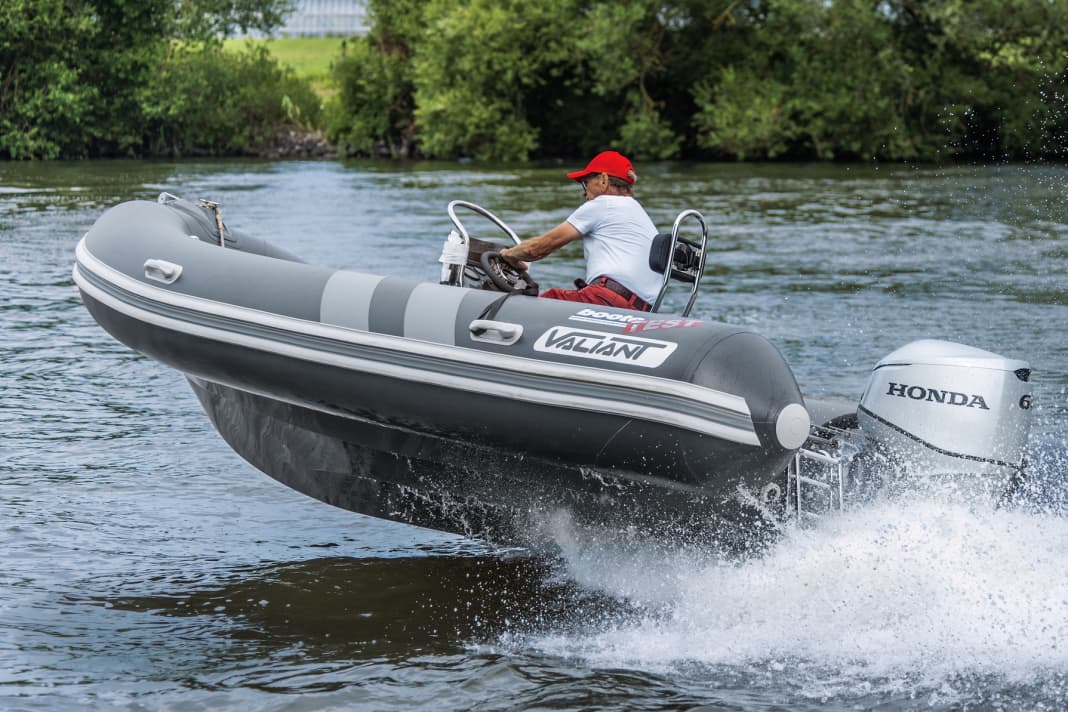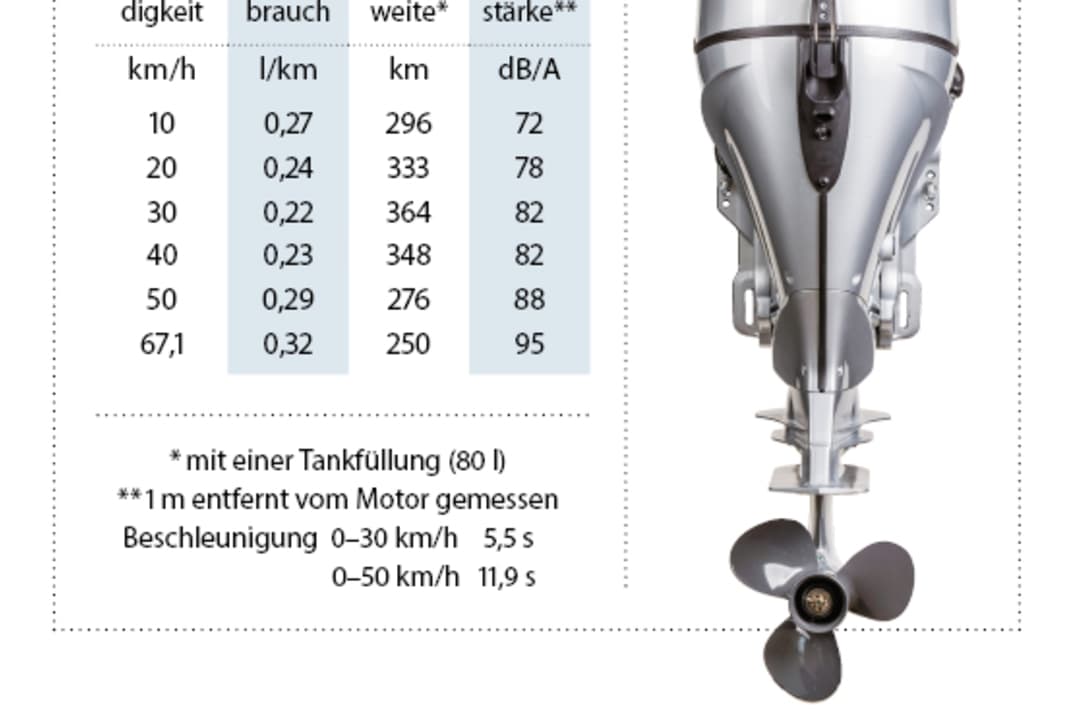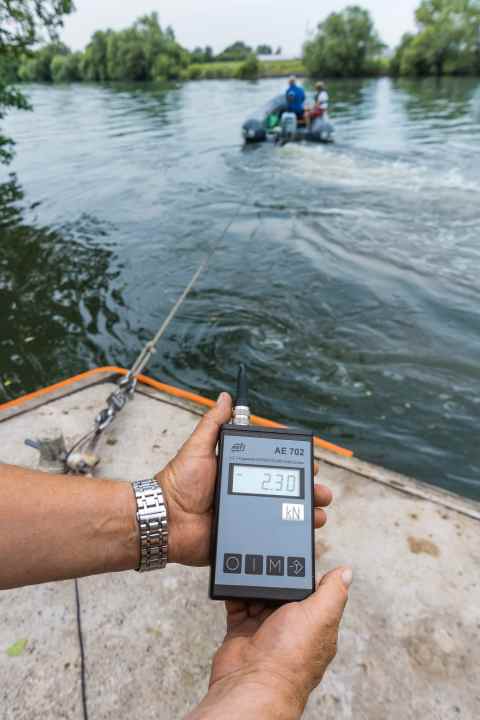





It has now been twelve years since the assembled 60 hp class was put to the test by the BOOTE testers. So it's time for a repeat of the class meeting. The list of participants includes "the usual suspects": Honda, Mercury, Suzuki and Yamaha. For Selva and Tohatsu, it is the first test date in this performance class. Evinrude, the first choice in terms of acceleration and maintenance requirements with its two-stroke at the time, turned the BOOTE testers down this time. As a result, only four-stroke engines will be testing their strength here today.
The candidates






The Great
If the alphabet alone determines the starting grid, Honda's BF 60 is in pole position. The 998 cc three-cylinder engine still has the largest displacement in this class. The cylinder head with overhead camshaft and four-valve technology and ECOmo (Economy Controlled Motor) are also unchanged trademarks. ECOmo uses a lambda sensor to check and regulate the fuel-air mixture. If the boat is gliding and the engine speed is "in the green zone", ECOmo makes the mixture leaner (more air) and thus reduces pollutant emissions. To generate more thrust and get the boat planing faster, "Blast" automatically shifts the ignition timing forwards and makes the fuel-air mixture richer. The on-board computer not only searches for and finds the correct ignition timing, but also controls the electronic petrol injection system, which calculates the optimum amount of fuel in every situation and determines the perfect moment for painless injection.
The all-rounder
Mercury's F 60 is also a repeat offender. Ten years ago it was the only four-cylinder engine in the test, but now it has two competitors in Selva and Yamaha. In the American engine family, the F 60 is the most powerful of its model series, which is almost identical in many respects, and advertises itself with a displacement of 995 cc, two-valve technology, high torque and electronics that can do more than just control petrol injection and ignition.
The newcomer
Apart from the fact that it and the long-established Yamaha are like two peas in a pod, Selva's Dorado 60XSR is one of the two newcomers in the test history of this performance class alongside the Tohatsu. The relationship cannot be overlooked and, like the "proper" participation of the Japanese engine manufacturer in the Selva S.p.A. company, is no secret. The abbreviation XSR stands for the special design of the electronic engine control system in the 996 cc in-line four-cylinder with two-valve technology, which is intended to ensure high torque and economical consumption. The only question is whether and to what extent the "normal" 60 EFI deviates from these ideals.
The acquaintance
Still a newcomer in 2010, Suzuki's DF 60 - a three-cylinder engine with a displacement of 941 cc - is more of an old acquaintance for the test crew today. Its still slim line shows that technical delicacies such as electronically controlled petrol injection and ignition, four-valve technology and two overhead camshafts, which are moved by a maintenance-free timing chain, do not necessarily lead to excess weight.
The little one
Small, light and inexpensive. With a displacement of 866 cc, a weight of 102 kg and a price below the 9200 euro mark, Tohatsu's MFS60A sets the standard in this test. Another unique feature of the three-cylinder engine is the valve control with one exhaust and two intake valves per cylinder.
The new old man
Yamaha's F60 has lost two kilos over the past few years. The engineers have not told us how. The design - four-cylinder in-line - and equipment, including 995 cc capacity, two-valve technology and electronic engine management, have remained unchanged.

Thrust effect
If thrust rather than top speed is at the top of the wish list, the thrust versions offered by the manufacturers are a good choice. Modified gear ratios and redesigned underwater parts allow propellers with a large diameter and reduced pitch to be fitted. Both together provide more thrust at the bottom line. And not just in theory. We measured the bollard pull, i.e. the tractive force of the drive, on both versions of the Honda BF 60. The "normal version" with a gear ratio of 2.07 : 1 pulled with the (engine) test propeller (11" x 16") at 3100 rpm with 2.36 kn (kilonewtons) or, in other words, with 241 kg. With the 2.33 : 1 ratio Power Trust gearbox, on which a propeller with a 14" diameter and "only" 9" pitch is mounted, the BFP 60 pulls at 3950 rpm with 4.00 kn, i.e. with 408 kg on the electronic scales. This makes it much easier to manoeuvre heavy boats. Our "light" Valiant 550 was one second faster with Power Trust when accelerating over the short distance (0-30 km/h), but then - no wonder - was far behind the normal BF 60, especially at top speed (almost 14 km/h).
The tools of the trade
A warning system is part of the management system and is still a must-have for all test engines. If the engine speed is too high, the oil pressure plummets, the engine overheats or the battery charge is not OK, the alarm bells ring. The engine control unit also switches on the warning lights and reduces the full load speed (max. 1500-2800 rpm). If the Honda gets too hot, the electronics force it to stop after 20 seconds. However, the engine can be restarted immediately. In addition to the warning system, the tachometer and trim indicator are class standard. Mercury's SmartCraft also displays the speed, consumption and battery voltage. Honda installs five round instruments for the same functions. If you also want to get this information from Selva and Yamaha, you have to invest in accessories, but then you get an electronic immobiliser as a bonus. Suzuki provides DF-60 buyers with a second round instrument as standard, on which they can also read the current consumption values.
Similarities
Clearly laid out operating instructions with easy-to-understand diagrams and texts provide information on what the electronics can do and what they display, how to handle the engine safely and conveniently and how to carry out simple maintenance work yourself. If there is a problem that cannot be solved using the do-it-yourself method, the only option is to call a mechanic who, equipped with the right hardware and software, can easily read out the engine's fault memory.
There is a consensus on the purpose of fuel filters. All manufacturers unanimously recommend large pre-filters with water separators. The crux of the matter is that none of them supply such a filter as standard. If you don't want to invest in useful accessories, you have to live with the miniature filters installed directly on the engine, which, despite the water alarm (Yamaha) or float indicator (Honda), cannot fulfil much more than an alibi function.
Differences
There are still differences of opinion on the subject of emergency starts. Some (Honda, Mercury) say: "Nothing is impossible" and supply an emergency start rope with handpiece as standard, while others believe that the average boater simply lacks the strength and the right tools. The tester tends to agree with the second opinion.
Opinions are also divided when it comes to the fuel tank. The 25-litre plastic tank is only available as standard on the Selva and Yamaha twins.
A matching aluminium propeller, the emergency stop switch and the conventional single-lever control for throttle and gearbox are standard on all motors. The buyer is free to choose the type of gearstick (top, underfloor or side-mounted). Plus point: At Suzuki, everything has the same price. A common feature of all gearsticks is a lock that prevents the engine from being started with a gear engaged or the transmission from being shifted above neutral at engine speeds, and the toggle switch for the power trim integrated in the gearstick lever. This allows the engine to be raised and lowered at the touch of a button while driving. If the trim is correct, the boat always moves in the optimum floating position.
Improvements
The protection against galvanic corrosion, which all motor manufacturers guarantee with sacrificial anodes installed on the bracket, on the underwater part and in the cooling system, is also perfect.
In the past, model variants with an underwater section specially designed for thrust were the exception rather than the rule, but are now part of the portfolio of all manufacturers. The same applies to tiller steering and trolling systems. (Tester's note: Selva has neither in its brochure, but will supply both on request). The latter allows the driver to change the idle speed up or down in "50 increments" by pressing the button. The overall package is designed to fulfil the wishes of (sports) fishermen and houseboat captains, who are multiplying rapidly on the charter market. Irrespective of this, RIBs, sports boats and cabin cruisers are still the firm favourites for engines equipped with long shafts, power trim, single-lever gears and wheel steering.
The audit
Valiant's 500 Sailing is the first choice for the class reunion at the height of summer (38 degrees in the shade). The 5.01 m long RIB can be powered with a maximum of 60 hp, has the correct (520 mm) transom height and an 80-litre built-in tank and weighs around 600 kg "loaded" with engine, steering console, jockey seat, two "riders" and 40 litres of petrol. As always, the manufacturer's technicians are responsible for installing the engine and tuning the propeller.
Mercury mounts its F 60 in the third hole. This means that the anti-cavitation plate is 2 cm above the bottom of the boat. With this and the perfectly tuned steel propeller, the Mercury is the fastest in the test at 67.3 km/h. The slowest, Tohatsu's MFS 60, struggled to break the 60 km/h barrier. The Honda comes closest to the Mercury (67.1 km/h).
The sprint
The competition between the "sprinters" is entitled "Upside-down world". Having just been the best, the Mercury lags behind when accelerating (0 to 30 and 0 to 50 km/h). Does the high engine mounting, which causes the propeller to ventilate even with little trim, take its revenge here? The winner is the Tohatsu, which has no chance at top speed. Selva takes home the silver medal. As with top speed, the identical Yamaha trails its Italian twin brother despite its steel prop.
Everyone wants to save fuel, but who is best at it? If you take the values measured at cruising speed (30-40 km/h) as a yardstick, the test winner is Suzuki. If you only look at the values in litres/km, the differences are in the second digit after the decimal point. So peanuts? Not at all. The calculated range shows just how small the difference can be. Here, the Suzuki is separated from the last-placed Selva by an impressive 114 kilometres. To put it bluntly, that's a lot of wood.
The Suzuki technicians are not really comforted by the fact that the sound makes the music. Although the operating noise of the DF 60 is anything but annoying, it is simply too loud at 90 dB/A when cruising. Only Honda's BF 60 is a real quiet performer, i.e. an engine that remains below the "pain threshold" of 85 dB/A in this driving range. The 96 dB/A measured in the full load range on the Mercury F60 clearly shows that a high-pitched engine can also have disadvantages in this area.
Conclusion
We were looking for the first among equals. We found a performance class in which there are hardly any major differences in terms of quality, handling and standard equipment - here Selva and Yamaha score points with a portable 25-litre tank.
These can be found in the pricing, where the difference between expensive (Yamaha) and inexpensive (Tohatsu) is 316 euros, and in the measurement results. Yamaha's F60 impresses with continuity. In other words, it does not make any significant slips either at the top or at the bottom.
In favour of the Tohatsu are its sprinter qualities, its weight and the five-year warranty, which is also available from Mercury and Selva. If you want the same duration with Honda and Yamaha, you have to pay extra. In terms of the measured values, the top speed favours the heavyweight Mercury, the fuel consumption and thus the range for Suzuki and the noise level for the Honda, which is the test winner in this point.
In practice, the test sextet impresses with functional controls and perfect starting behaviour. Whether cold or warm, the engines start spontaneously and run smoothly straight away. No smoke or fumes.
The decision in favour of one or other engine in this horsepower class is therefore more likely to be made in the gut than in the head. One argument that should not be underestimated is the where and how of the dealer. Long journeys to and from the dealer are annoying and costly. And I always prefer a tidy and well-equipped workshop to a "cheap DIY centre".
Dealer references
- Honda BF 60 LRTU: www.honda.de
- Mercury F 60 EFI ELPT: www.mercury-marine.com
- Selva Dorado 60XSR EFI: www.selvamarine.com
- Suzuki DF 60 ATL: www.suzuki-marine.de
- Tohatsu MFS60A ETL: www.tohatsu.de
- Yamaha F60FETL EFI: www.yamaha-motor.de

